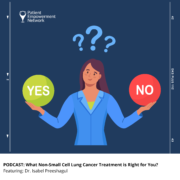Understanding Non-Small Cell Lung Cancer: Types, Biomarkers, and Treatment Insights
Understanding Non-Small Cell Lung Cancer: Types, Biomarkers, and Treatment Insights from Patient Empowerment Network on Vimeo.
How can non-small cell lung cancer (NSCLC) patients be empowered when newly diagnosed? Expert Dr. Joshua Sabari from NYU Langone discusses what he shares about NSCLC incidence rates, histology, and biomarkers with patients and families.
[ACT]IVATION TIP
“…know what type of cancer you have, the histology. Whether it be adenocarcinoma or squamous cancer. And equally as important, know your biomarker, what mutation is driving your cancer and what PD-L1 expression your tumor harbors.”
Download Resource Guide | Descargar guía de recursos
See More from [ACT]IVATED NSCLC Biomarkers
Related Resources:

Navigating Lung Cancer Biomarker Testing | Challenges and Solutions for Timely Access |

|

Equity in Action | Addressing Biomarker Disparities in Lung Cancer |
Transcript:
Lisa Hatfield:
Dr. Sabari, how do you explain non-small cell lung cancer to your patients and their care partners and families?
Dr. Joshua Sabari:
Yeah, so non-small cell lung cancer is a common cancer in the United States. It’s actually the third most common cancer. And really, you know, non-small cell lung cancer makes up multiple different histologies or types of cancer in the lung. The most common being adenocarcinoma, which is probably about 60 percent to 70 percent of non-small cell. We also hear about squamous cell cancer. And what this means is what is the original cell where the cancer arose? So adenocarcinomas occur in gland cells.
Whereas squamous cancers occur in cells such as the lining part of the lung. And it’s important to know what type of cancer you have because these are treated differently. And when you think about non-small cell lung cancer, we said there are many different ways that people can present. Some people can have shortness of breath, cough, you know, and weight loss. Whereas other people may have no symptoms at all.
So again, the important thing here is that lung cancer can be diagnosed in anybody. All you really need to have is lungs. We see lung cancer in people who’ve smoked in the past, but we also see lung cancer in people who’ve never smoked. And that brings me to a really important point. Once we understand the histology, the type of cancer that it is, we then want to understand some of the biomarkers, right? What are biomarkers?
Biomarkers are distinct sort of entities that help us better understand things about your cancer. And allow us to potentially match people to therapies. So two biomarkers that we generally think about, one is molecular or mutational biomarkers. These are the mutations or abnormalities that led to the cancer. Two kinds of mutations. One is a germline mutation, which is inherited from mom and dad and has a risk of being passed on to your children.
These are uncommon in lung cancer. The second type is called a somatic mutation. And these are mutations that are acquired from the environment, from smoking, for example, from pollution, from radon. And these are not generally inherited mutations. So really important to understand mutational profile and ask your doctor, what is my mutation? Because we can then match people to targeted therapies. The second biomarker that is really important is something called PD-L1 or programmed death-ligand 1. I know it sounds exotic.
But that’s a biomarker that helps us guide how likely immunotherapy will work in your cancer. If the PD-L1 expression is high, greater than 50 percent, immunotherapy may be a very good option. If the PD-L1 expression is low, immunotherapy may sometimes be used, but more commonly in combination with chemotherapy. So my activation tip here is know what type of cancer you have, the histology. Whether it be adenocarcinoma or squamous cancer. And equally as important, know your biomarker, what mutation is driving your cancer and what PD-L1 expression your tumor harbors.










